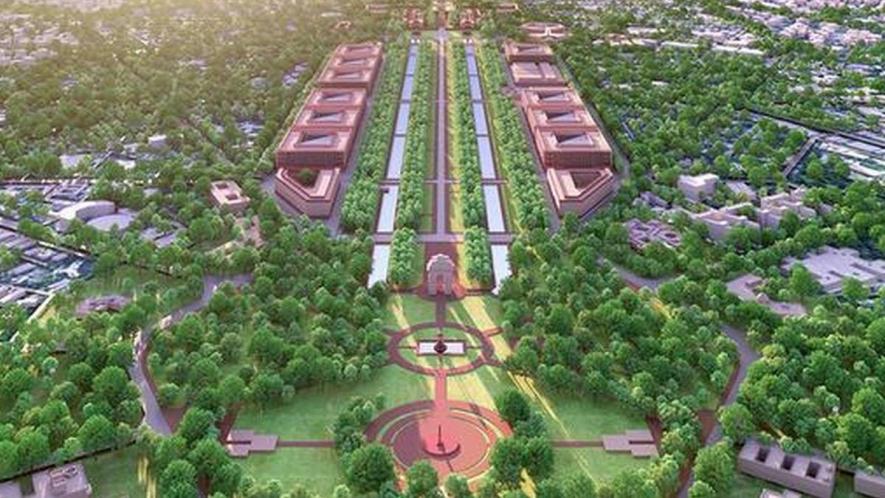Central Vista Redevelopment Project: Greening or Greenwashing?

Image Courtesy: The Hindu
The Sunday Express of July 19 carried an article by Shivam Patel outlining the greening plans that HCP, the “chosen” firm from Gujarat headed by Bimal Patel, has for the Central Vista. This article appeared just after the Supreme Court began hearing seven detailed challenges to the government’s Central Vista Redevelopment project on July 17. The article carries only HCP’s version of what they propose to do even though this project is now a public controversy and has provoked much opposition from politicians and citizens. Nevertheless, this article showcases HCP’s limited view of the environmental issues at stake in this unnecessary and wasteful project that is proposed to be built at breakneck speed in the most polluted city of the world.
To put matters into perspective, this proposed project of the government is being pursued in the worst possible context of the escalating economic crisis and now a pandemic because it is the “PM’s dream”. Since September last year, when the project was announced, government agencies involved in various legal procedures from the Notice Inviting Bid to the array of approvals have stymied and blocked information sharing and public participation in the project planning. Even the project's architect, who has made claims about upholding principles of transparency and openness, has simply capitulated these aspects of public work in the interests of “pragmatism” or getting the job done for the government. As a result, worried citizens have had no choice but to knock the doors of the judiciary.
Greenwashing
HCP’s plans to deal with the trees of Central Vista, as outlined in the article, are what’s called greenwashing. This is a strategy whereby harmful projects accommodate superficial environmental measures in order to look good. This plan to reorder the tree “palette” on the Central Vista according to Lutyens’ colonial plan is not only proof of the project’s blindness to today’s climate change and environmental realities that many Delhiites already experience. It is also an indicator of the lack of imagination in the project about what constitutes environmental and social “public goods” in these apocalyptic times.
Also watch: Central Vista: Threat to Delhi's Environment
Those in charge of this project may hope to distract the public from the questions of the arbitrary and unjustified transfer of high value public lands to government use. Of what use would a new set of trees be to the public if Central Vista is turned into an elite, power corridor exclusive to the highest political and government offices? How does a plan to have more diverse and beautiful trees on Central Vista justify wasting public funds in creating more new high security bungalows for the Prime Minister and Vice President? Can tree planting on Central Vista make the appropriation of our urban commons acceptable?
The age and care of the trees on Central Vista is not a new issue. They certainly will not survive the scale and nature of construction proposed for the area. But HCP’s mantra of “problem solving” sees the environment only as an inconvenience to its project and which needs some fixing. The earlier versions of their green claims included compensatory afforestation and tree transplantation of the Central Vista trees. These have already been criticised by the residents of Delhi who care about tree ecologies that are being lost rapidly to road expansion and commercial real estate projects. They are well aware of the failures of these tree “management” policies. The proposal by HCP to recreate the colonial tree designs on Central Vista seems to be the latest of the facile attempts to allay the real environmental fears of the city.
The truth is there is simply no environmental thought in this project being pushed by government fiat. The project has already abused weak environment regulations like the Environment Impact Assessment (EIA) notification to its advantage with the support of unaccountable bodies such as the Expert Appraisal Committee of the Environment Ministry. Other institutions like the high level Central Vista Committee and Delhi Urban Art Commission (DUAC) also adopted a narrow and piecemeal approach to review the impacts of the project.
Socio-ecological blunders
HCP’s Bimal Patel has spoken at several closed door architectural forums and with “editors and town planner” which the government is passing off as public consultations. If those forums were open to common people and environmental lovers who have been at the receiving end of the high modernist governmental projects implemented by HCP, we would have a full list of the socio-ecological blunders caused by these projects. The gated park built in Kankaria lake in Ahmedabad that fenced off a public space by erecting a wall around it and restricting it to a ticketed entry and the Sabarmati Riverfront Development Project that transformed the river ecology and displaced the range of socio-economic and cultural uses of the riverbanks including the weekly market or “Ravivari” are just two such examples.
A good number of HCP’s high profile projects are also entangled in opposition due to what they once accepted to Vadodara’s activists as their own “ecological blind spot”. HCP has tried to implement several riverfront projects such as the Vishwamitri Riverfront Development Project (VRDP) in Vadodara and Pune riverfront development project. These are similar to the Sabarmati project and as highlighted by South Asia Network on Dams, Rivers and People, they “treat rivers as extension of urban spaces and are more about encroachment of floodplains and river beds for real estate than restoration.” The commercialisation of the public lands of Mumbai Port Trust’s eastern waterfront to create a “Cruise Tourism Capital of the country” is also one of HCP’s projects. Hussain Indorewala’s careful research on this project concludes that it is “a real-estate megaproject with the aim of converting power into property” at the cost of the city’s urgent public priorities.
There is a river front component in the Central Vista Redevelopment project too. When the project was criticised in November-December last year for its role in converting public land into government land, the project authorities added the component of 25 acres of “New India Gardens” on the western bank of the Yamuna. This component was slipped into the project and offered as a gift of public space back to us. There has been no discussion so far about its potential effects of this take over of the riverfront because the focus has been on the impacts on the built heritage and public nature of the national space between Rashtrapati Bhavan and India Gate.
In the interviews given over the last few months, Padmashri Bimal Patel has handwaved these massive problems of social inclusivity and ecology in HCP’s projects as routine occurrences of “people venting their apprehensions”. To rebuild the centre of India’s democratic space, HCP holds only its ‘client’s’ needs as sacrosanct, which according to them is the Government of India. That is not an adequate or an appropriate standard for large public projects to live up to in a democratic welfare state.
The authors are researchers with the Central for Policy Research. The views are personal.
Also read: Why the Central Vista Redesign Project is on Shaky Ground Itself
Get the latest reports & analysis with people's perspective on Protests, movements & deep analytical videos, discussions of the current affairs in your Telegram app. Subscribe to NewsClick's Telegram channel & get Real-Time updates on stories, as they get published on our website.
























